CHAPTER 8
Sweets
On most food pyramids, the peak rung comes with what amounts to a warning sign: eat very little of these foods! That’s why the top rung is so small. Proportionately, you’re supposed to have only a small taste.
Not on the Beat Diabetes Pyramid. The sweets that made it onto the top rung here—fruit, no-added-sugar frozen fudge pops and ice pops, many no-added-sugar candies, other sugar-free desserts, even chocolate—all qualify as fighters for weight loss and against diabetes, and you can eat generous amounts of them.
In fact, the only reason these foods occupy such a small rung is that sweets tend to be a small part of eating in general. After all, the word dessert comes from a French verb meaning “to clear away the dishes,” and sweets are indeed the incidental food—an elegant final flourish after the meal or a quick taste you crave in an afternoon snack. These aren’t foods that take up a large space on the plate or carry out a large role in any eating plan.
But there’s no denying that the so-called sweet tooth is a universal human characteristic. From time to time, everyone craves the rich pleasures of sweet tastes, and it would be foolish—and ineffectual—to deny that appetite or set limits on it.
And as the sweets at the top of the Beat Diabetes Pyramid prove, you don’t have to. Like all the foods on the Pyramid, the sweets at the top are there for good reasons, should be eaten and should be enjoyed generously.
To many people, of course, the idea that diabetics or those trying to prevent diabetes should eat sweets sounds not just weird but downright heretical. After all, these people ask, aren’t sweets the very first group of foods diabetics are told to abandon? Not these sweets. There are sweets on the Beat Diabetes Pyramid that literally fight diabetes and its complications and help weight loss. Others are there because they offer the promise of sweetness without some of the burdens that some sweet foods do indeed carry: bad fats, for example, or refined carbohydrates. The latter therefore satisfy the sweet tooth that every human has but do so in a completely neutral way. That’s why they play an important role in any overall eating plan.
Let’s take the sweets one at a time.
FRUITS
Like vegetables, fruits present a wide-ranging and multicolored variety of tastes and textures. And, like vegetables, to those seeking to lose weight and prevent or manage diabetes, they offer the powerful pluses of fiber and phytonutrients with a low calorie content.
What often makes people hesitate about fruit is that it contains sugar. And it is true enough that the sugar it contains is no different from the sugar in the richest-tasting candy bar or the most elaborate pastry. After all, sugar is sugar.
But the amount of sugar in fruit is far less than the amount in even a small portion of candy or pastry, as you’ll see in the demonstrations that follow. And whereas the candy and pastry are made with refined carbohydrates and thus lack any nutritional value, the fruit is packed with the phytonutrients and fiber that help you lose weight and fight diabetes.
NO “GOOD” OR “BAD” FRUIT
Remember back in Chapter 4 when we talked about glycemic index and glycemic load vis-à-vis vegetables? You’ll recall that the index measures how quickly the sugars in food enter the bloodstream, and that glycemic load refines that measure by factoring in the amount of carbohydrates in an average serving of the food. We concluded that what really makes sense is to take into consideration all the factors in the diet and thereby look at overall glycemic impact. The same is true of fruits.
For example, the glycemic index of watermelon is 72, a high measure that might put you off eating it. Its glycemic load is 4, which is low and would encourage you to eat it. But in addition, nutrients in the rest of the meal you’ve eaten or in the diet as a whole need to be taken into consideration to get a sense of overall impact. For example, healthy protein, fiber and good fats all influence the rate of sugar entry into the blood. Bottom line: if you’re eating the Pyramid way, which is high in protein and fiber, no food—and that means watermelon and all other fruits—should be considered off-limits.
There’s another consideration as well. As small incidental snacks, candies tend to be consumed almost mindlessly; they thus tempt us to eat more—more, certainly, than is shown in the demonstration. Eating more and more of these sugar-filled, nutrition-free items eventually mitigates against weight loss and diabetes prevention, while the fruit, with fiber, phytonutrients and a low calorie count, advances both those goals.
WHICH SNACK?
We’ve paired relatively small candy servings—and in one case a tart—with pretty good-sized servings of fruit. The calorie differences speak for themselves. That’s true whether the fruit is raw, like the cherries, banana and cantaloupe, or cooked, as in the baked apple.
Bottom line? The sugar in fruit is great for satisfying your sweet craving without adding the calories that stymie weight loss and the fight against diabetes. In fact, the fiber and phytonutrients you’ll take in with these fruit snacks will help you achieve both aims—weight loss and diabetes prevention or management.
And don’t forget to check out the recipe for Tutti-Frutti Baked Apples.

3 sticks red licorice
120 calories
vs.
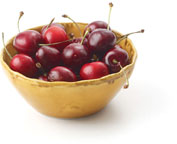
1 cup cherries
50 calories

2 ounces gummy bears
200 calories
vs.
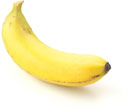
banana
100 calories

1½ ounces jelly beans
150 calories
vs.
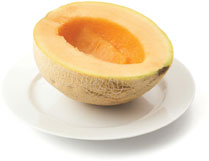
½ cantaloupe
60 calories

apple tart
390 calories
vs.
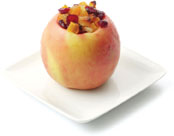
Tutti-Frutti Baked Apple
130 calories
SWEETS ON A STICK
No one is claiming that no-sugar-added frozen fudge pops, ice pops or fruit-and-cream pops contain any particular nutrients that will help you battle diabetes and lose weight. It’s what these sweets don’t contain that make them such important building blocks of the Beat Diabetes Pyramid: they don’t have sugar, and they don’t have fat.
And then, of course, they do contain one exceptionally important ingredient for any eating plan: their taste.
That makes these particular sweets extremely important in an overall eating plan aimed at weight loss and diabetes prevention or management: they satisfy that universal human sweet tooth without adding to either your waistline or your risk of this killer disease. Bottom line? These no-added-sugar frozen treats can be enjoyed anytime, for any reason, in any quantity.
Really? Really. Our nutritionist is adamant on this point. To those who object to buying these treats because they come in packages of a dozen and they’re afraid they’ll eat “more than one,” she responds: “Feel free!” In fact, she says, even if you are diabetic, you can eat as many as you need to feel satisfied and still be ahead in the fight for weight loss and against diabetes. Those who indulge freely in these low-calorie treats tend to eat less of their high-calorie counterparts over time.
As you can see in the photograph, there is a very substantial range of these products. And if you still doubt that you can enjoy these products in an eating plan that advances weight loss and fights diabetes, check out the following food demonstrations.

GENEROUS SERVING
Remember we said that the sweets on the top rung of the Beat Diabetes Pyramid should be eaten generously? Here’s an example:
Between a bare mouthful of chocolate taste or one, two, three, even four Tofutti Chocolate Fudge Treats for the same calorie count, you can afford to be generous.
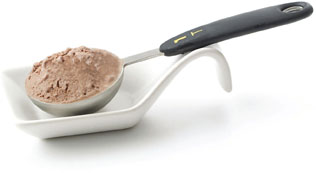
Rounded tablespoon rich chocolate ice cream
120 calories
=
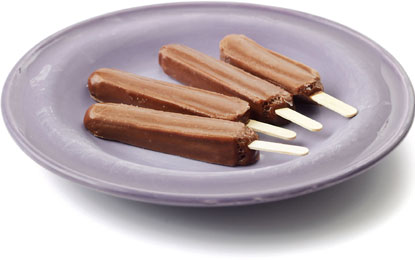
4 Tofutti Chocolate Fudge Treats
120 calories
NO-ADDED-SUGAR CANDIES
There are times when you just need a quick hit of something sweet, and there is no dearth of no-added-sugar candies to meet that need—lollipops, gummy bears, sourballs, jelly beans, candy canes…you name it. For the most part, the candies on the Beat Diabetes Pyramid are hard candies or chewy fruit candies; these are lower in fat and calories than the nuggets or cream candies.
As with all the foods on the Pyramid, the watchword about how much to eat is “till satisfied.” At least as far as weight loss and diabetes prevention are concerned, these candies are no exception. The sweeteners used in these candies are mostly sugar alcohols, which are both lower in calories than regular sugar and are much more slowly absorbed into the bloodstream. Bottom line: they simply don’t affect blood sugar levels in any appreciable way.
There is one caveat about eating a lot of these candies, however, and it’s often stated on the packaging: “excessive consumption may have a laxative effect.” So if you’re not used to eating these candies, go easy—at least at first.
OTHER SUGAR-FREE DESSERTS: ONE CAUTION
When buying—or baking—such other sugar-free desserts as cakes, pies, cookies, tarts and the like, there’s one issue to keep in mind. Although the food may lack sugar, it may well contain refined carbohydrates in the form of flour, and it might also have a fair amount of bad fat—neither of which helps you lose weight or prevent or control diabetes, as the picture about sugar-free cookies makes clear.
One reason is that the human body processes flour and other starches much the same way it processes sugar. After all, refined carbohydrate is refined carbohydrate—and the result for weight control and diabetes prevention is equivalent.
So it’s important not to be taken in by the labeling; the “sugar-free” claim is true, but it doesn’t tell the whole story. In fact, we sometimes refer to these foods as “saboteurs,” because in the guise of doing good things for weight loss and your health, they actually subvert those goals.
Beware!
STRAWBERRY DRAMA
Check out the representations of fat and sugar content along with the calorie counts in these strawberry desserts. They tell a pretty dramatic story.
Note that to eat the calorie count of the scoop of ice cream, you would have to eat twenty-two of the frozen pops.
Be aware also that Italian ices and granitas are equivalent to the sorbet in this demonstration in terms of calories and sugar content.
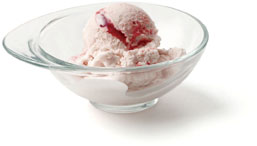
1-cup scoop rich strawberry ice cream
540 calories, 33 grams fat, 48 grams sugar

33 grams bad fat = 6 ½ pats butter

12 teaspoons sugar
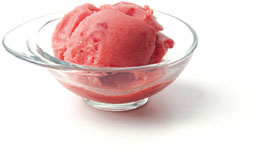
1-cup scoop strawberry sorbet
200 calories, 0 grams fat, 48 grams sugar

12 teaspoons sugar

0 grams bad fat

3 sugar-free strawberry Creamsicles
75 calories, 0 grams fat, 0 grams sugar
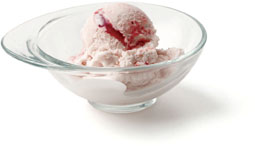
1-cup scoop rich strawberry ice cream
540 calories
=
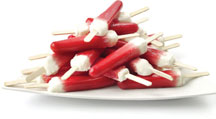
22 sugar-free strawberry Creamsicles
540 calories, 0 grams fat,
0 grams sugar
LO-CAL SWEETENERS: NO FEAR!
If you have read horror stories about sweeteners in no-added-sugar treats, sugar-free candies or diet beverages, relax: the stories are not supported by scientific evidence. All sweeteners approved by the U.S. Food and Drug Administration (FDA) have been subjected to rigorous scrutiny, and we consider low-calorie sweeteners both safe and useful.
Useful they certainly are. Sweeteners are one area where “natural” is not necessarily better: sugars, honey and syrups are not helpful where both weight loss and fighting diabetes are concerned. So by all means, use the sweeteners to take the edge off a tart beverage, satisfy your sweet tooth or in cooking, and don’t worry about them in the treats on the Beat Diabetes Pyramid.
For the most part, the dessert recipes in this book call for and have been tested with Splenda, but by all means follow your own lo-cal sweetener preference.
One caveat: we do not recommend aspartame—sold as NutraSweet or Equal—for use in cooking, although it’s fine as an addition to a drink or sprinkled on your fruit.
A NOTE ON CHOCOLATE: THE GOOD KEEPS GETTING BETTER
Chocolate is the gift that keeps giving—as rich in health benefits as it is in pleasurable taste. Yes, chocolate contains saturated fat, but unlike other saturated fats, its fat content does not raise blood cholesterol levels. And cocoa, which is chocolate without the fat, is even low in calories.
We’re talking here about dark chocolate—not milk or white chocolate, which are loaded with sugar. White chocolate, in fact, is not technically chocolate at all and delivers none of the considerable health benefits of chocolate.
But at the heart of the matter is chocolate’s content of flavonols, phytonutrients found in many fruits and vegetables, including the cocoa bean. Especially where diabetes is an issue, flavonols pack a powerful health punch, helping to raise insulin sensitivity, lower blood pressure, decrease bad cholesterol, raise good cholesterol and promote the health of blood vessels. There’s a simple way to put it: chocolate is very, very good for heart health.
Several studies have shown that insulin resistance drops and insulin sensitivity rises after ingesting chocolate—specifically, dark chocolate. That gives chocolate a special punch when it comes to preventing and/or managing diabetes.
Equally powerful is research showing chocolate’s impact on blood pressure. One recent study demonstrated that the drop in blood pressure from consuming cocoa products was equivalent to the decrease that would have been achieved had the study participants been taking blood pressure medication! Well, how would you rather control your blood pressure—with prescription drugs or with cocoa?
Cocoa and chocolate have also been proven to be beneficial where vascular health is concerned. Studies have shown that these foods help limit the buildup of plaque in the arteries by lowering LDL cholesterol. At the same time, they help raise HDL cholesterol levels. Other studies demonstrate the power of chocolate to inhibit blood platelet activity and limit clotting—the same sort of thing aspirin does—and to keep the blood vessels relaxed and dilated, thus helping to maintain a healthy blood flow.
Yes, there are calories to contend with, so how can you get these stunning benefits of the flavonols without the calories? One answer is by focusing on cocoa—regular cocoa, not dutch cocoa, which is processed with an alkali that actually destroys the flavonols. Try adding a teaspoon of cocoa to your hot or iced coffee for a mocha effect. Or mix it into your sugar-free cocoa mix for a healthful hot chocolate on a cold winter’s day. If you find the taste isn’t sweet enough for you, add a packet or two of Splenda or your preferred low-calorie sweetener.
Another way to get the benefits of flavonols is sugar-free dark chocolate candy bars. Although caloric, these bars are fine for an occasional treat.
One note: when making desserts with chocolate, always use unsweetened or baking chocolate (100 percent cacao), and sweeten with sugar-free syrup, sugar-free preserves or the low-calorie sweetener of your choice.
As you see, chocolate can be your friend. And as the recipes that follow demonstrate, where weight loss and diabetes management are concerned, chocolate lovers really can have it all.
BEAT DIABETES BROWNIES
1 cup granulated Splenda
½ cup whole-wheat flour
½ cup unsweetened soy protein powder*
6-8 tablespoons unsweetened cocoa powder
1 ¼ teaspoons baking powder
¼ teaspoon salt
2/3 cup brewed coffee, regular or decaffeinated
½ cup sugar-free syrup (preferably chocolate, but any flavor is fine)
1/3 cup canola oil
1 tablespoon vanilla extract
½ cup coarsely chopped walnuts or pecans
Preheat oven to 350°F. Oil an 8- or 9-inch square baking pan, or coat with nonstick spray.
1. In a large bowl combine Splenda, flour, protein powder and salt. Add coffee, syrup, oil and vanilla, and stir until well blended.
2. Pour mixture into prepared pan. Sprinkle chopped nuts evenly over top and press gently into batter.
3. Bake 20–25 minutes, or until a toothpick inserted near the center comes out clean. Cool thoroughly in pan before cutting into squares.
Yield: 12 brownies

Regular brownie (2 ½ ounces)
360 calories, 14 grams fat, 20 grams sugar
= 3 pats butter, 5 teaspoons sugar
vs.

Beat Diabetes Brownie
(per 2 ½-ounce brownie)
110 calories
9 grams fiber
= no sugar added
less than 1 gram saturated fat
1 package sugar-free instant lemon pudding
1 ½ cups soy milk
2 tablespoons lemon juice
¼ teaspoon grated lemon zest
1 ½ cups sliced strawberries and/or raspberries
LEMON-BERRY PARFAIT
1. In a bowl, beat together pudding mix, soy milk and lemon juice, and zest until smooth.
2. Refrigerate for about 15 minutes to allow mixture to thicken slightly.
3. Divide pudding and berries evenly among 3 dessert dishes, alternating layers of pudding and berries.
Yield: 3 servings
105 calories per serving

Lemon square (pastry)
420 calories, 0 grams fiber
20 grams fat = 4 pats butter
48 grams sugar = 12 teaspoons sugar
vs.

Lemon-Berry Parfait
105 calories
4 grams fiber
0 grams fat
0 grams sugar
1 ounce unsweetened chocolate, chopped
1 ½ brewed cups coffee, regular or decaffeinated
1 cup soy milk
1 package sugar-free chocolate pudding mix, not instant
Pinch of salt
1 teaspoon vanilla extract
1 tablespoon rum or brandy, or 1 teaspoon flavoring (rum, almond, orange, maple, hazelnut, etc.)
BEAT DIABETES CHOCOLATE FONDUE
1. Add chocolate and coffee to a medium saucepan. Stir mixture over low heat until chocolate is melted; remove from heat. Add soy milk, pudding mix and salt, and stir or whisk until mixture is smooth.
2. Cook over medium heat, stirring frequently, until mixture comes to a boil and begins to thicken. Stir in vanilla and rum or brandy, or other flavoring.
3. Serve warm, in a fondue pot, with assorted fruit.
Yield: about 6 ½-cup servings

½ cup regular chocolate fondue
400 calories, 35 grams fat,
20 grams sugar
= 7 pats butter, 5 teaspoons sugar
vs.
* The saturated fat, represented by the butter, is from the chocolate in the recipe. The fat in chocolate, though it is saturated, does not raise blood cholesterol. The saturated fat in the regular fondue, however, is from both chocolate and cream; the latter does raise cholesterol.

½ cup Beat Diabetes Chocolate Fondue
60 calories
3 grams fat*
= ½ pat butter,
no sugar added
TUTTI-FRUTTI BAKED APPLE
4 large apples
1 cup diced mixed fruit, fresh or frozen (cherries, peaches, pineapple, etc.)
¼ cup sugar-free jam or marmalade
2-3 packets Splenda
¼ teaspoon cinnamon
Preheat oven to 350°F.
1. Core the apples and place in a 9-inch round or square baking pan.
2. Mix remaining ingredients together in a bowl.
3. Fill the apples with the fruit mixture, mounding any additional fruit on top of each apple.
4. Add a few tablespoons of water to the pan and cover with foil.
5. Bake 30 minutes; remove the foil and bake an additional 15 minutes, or until apples are tender. Serve warm or cold.
Yield: 4 servings
130 calories each
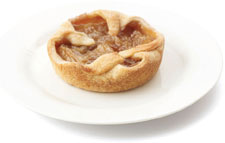
Apple tart 390 calories
vs.
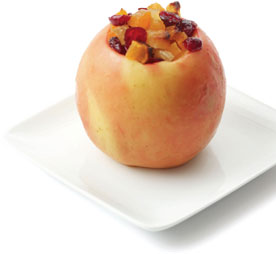
Tutti-Frutti Baked Apple
130 calories